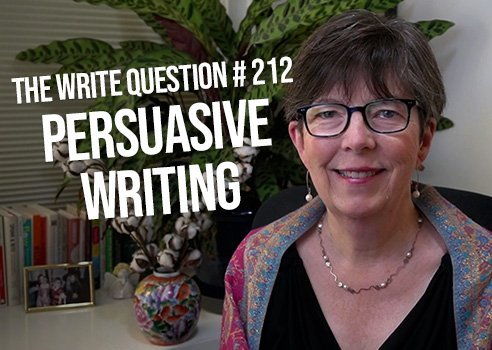Viewing time: 4 mins 45 secs
The Write Question is a weekly video podcast all about writing. Today’s question? Is there a structure for persuasive writing? If you have a question you’d like me to answer you can email me, tweet me @pubcoach, or leave a message for me at the Skype account, The Write Question.
Transcript:
Is there a structure for persuasive writing? That’s the topic I’m addressing today in The Write Question. I’m Daphne Gray-Grant, the Publication Coach.
I have a question from Jason Carroll, a writer based in Columbus, Ohio. Here’s what he’s asked by email…
“Academic writing is often done to persuade readers of a position. Is there a general structure for persuasive writing?”
Thanks for your question Jason. The first thing I’d say about academic writing is that if you’re looking for good marks, don’t search for a cookie-cutter formula.
Instead, begin by understanding the number of words your paper needs to be. I find that most universities talk in page counts, which are potentially misleading. After all, the number of words on a page is going to vary greatly depending on the size of the type you use, your line spacing and your margins.
So, if your professor says 12 pages, figure out how many words are expected on one of those pages and multiply that by 12. The reason this is so useful is because Microsoft Word tells you EXACTLY how many words you’ve written at the bottom of the screen. This way, you’ll always know how much more writing you have left to do.
The length you have available should also guide your research process. After all, if your paper is 750 words, you’ll need far fewer arguments than if it’s 2500 words.
Next, get a clear understanding of what your specific professor wants. Every professor is different and some will expect a five-point essay while others will demand something much more sophisticated.
A concept that can help you in either case, however, is represented by the handy acronym PEEL. It stands for Point, Evidence, Evaluation and Link.
I’m going to assume you already understand that the argument you want to make is your point. Be sure to state it in the opening paragraph of your essay.
The word evidence refers to facts and citations from others who agree with you — or, in other words, arguments that support your point. Remember that you mustn’t plagiarize and that even when you paraphrase someone else’s ideas, you need to give them full credit.
Once you’ve presented your evidence, move on to evaluation. This is where you not only argue the merits of your point but you also present any evidence against it, which you can then counter.
Presenting other points of view is a smart move that will show your thoughtfulness and thoroughness and will strengthen your argument.
Then, link your point to the point you’re going to make in the next paragraph. This type of connecting statement will make your writing more sophisticated and easier to read. In the show notes, below, see a link to my post on bridges for writers.
While the PEEL system was developed for high school students, see link in the show notes, it’s still a useful discipline to remember once you’re in college.
It will remind you not to make sweeping generalizations without evidence and it will also help you to include an analysis of those who disagree with you.
Finally, let me wrap up with the words of sci-fi author and product strategist Ramsey Isler: “All good writing is persuasive writing —persuading the reader to buy what you’re selling, to side with you, to believe the tales you tell.”
Jason, it’s worth reminding yourself of the huge value of persuasive writing even if you don’t end up pursuing an academic career. In the business or professional world, just about every email you produce will benefit from being a haiku of persuasive writing. Be sure to learn this skill well.
*
Viewers, if you have any writing-related questions, I’d be happy to do a video on them. Just send me a quick email, daphne@publicationcoach.com, or put a note in the comments section of this YouTube video.
And, if you’d like to learn more about how to make writing a happier and more rewarding process, check out my latest book Your Happy First Draft. I don’t sell it in bookstores or via Amazon. The only place to buy it is on my website, link on the screen below and in the show notes.
Links
Why writers need to build bridges


